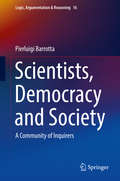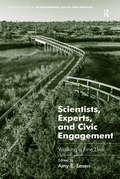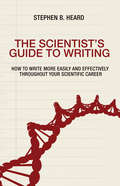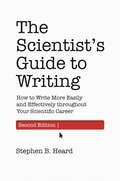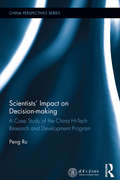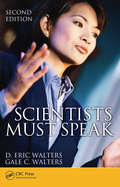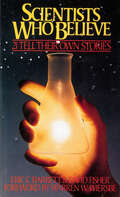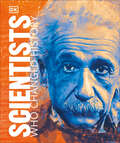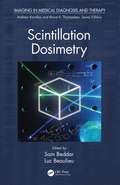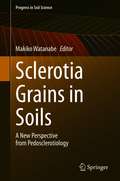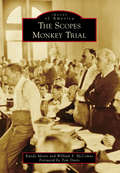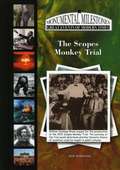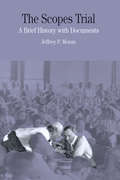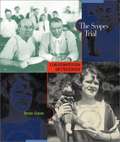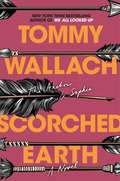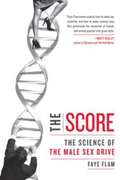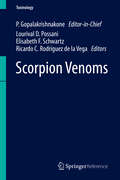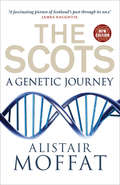- Table View
- List View
Scientists, Democracy and Society: A Community Of Inquirers (Logic, Argumentation And Reasoning Ser. #16)
by Pierluigi BarrottaThis monograph examines the relationship between science and democracy. The author argues that there is no clear-cut division between science and the rest of society. Rather, scientists and laypeople form a single community of inquiry, which aims at the truth.To defend his theory, the author shows that science and society are both heterogeneous and fragmented. They display variable and shifting alliances between components. He also explains how information flow between science and society is bi-directional through “transactional” processes. In other words, science and society mutually define themselves. The author also explains how science is both objective and laden with values.Coverage includes a wide range of topics, such as: the ideal of value-free science, the is/ought divide, “thick terms” and the language of science, inductive risk, the dichotomy between pure science and applied science, constructivism and the philosophy of risk. It also looks at the concepts of truth and objectivity, the autonomy of science, moral and social inquiry, perfectionism and democracy, and the role of experts in democratic societies. The style is philosophical, but the book features many examples and case-studies. It will appeal to philosophers of science, those in science and technology studies as well as interested general readers.
Scientists, Experts, and Civic Engagement: Walking a Fine Line (Routledge Studies in Environmental Policy and Practice)
by Amy E. LesenHow do scientists, scholars, and other experts engage with the general public and with the communities affected by their work or residing in their sites of study? Where are the fine lines between public scholarship, civic engagement, and activism? Must academics 'give back' once they collect data and publish results? In this volume, authors from a wide range of disciplines examine these relationships to assess how they can be fruitful or challenging. Describing the methodological and ethical issues that experts must consider when carrying out public scholarship, this book includes a checklist for critical factors of success in engagement and an examination of the role of digital social media in science communication. Illustrated by a range of case studies addressing environmental issues (climate change, resource use, post-disaster policy) and education, it offers an investigation into the levels and ways in which scholars can engage, and how and whether academics and experts who engage in community work and public scholarship are acknowledged and rewarded for doing so by their institutions. Also bringing into the debate the perspective of citizens who have collaborated with academics, the book offers an exploration of the democratizing potential of participatory action research.
The Scientist's Guide to Writing: How to Write More Easily and Effectively throughout Your Scientific Career
by Stephen B. HeardThe ability to write clearly is critical to any scientific career. The Scientist's Guide to Writing provides practical advice to help scientists become more effective writers so that their ideas have the greatest possible impact.Drawing on his own experience as a scientist, graduate adviser, and editor, Stephen Heard emphasizes that the goal of all scientific writing should be absolute clarity; that good writing takes deliberate practice; and that what many scientists need are not long lists of prescriptive rules but rather direct engagement with their behaviors and attitudes when they write. He combines advice on such topics as how to generate and maintain writing momentum with practical tips on structuring a scientific paper, revising a first draft, handling citations, responding to peer reviews, managing coauthorships, and more.In an accessible, informal tone, The Scientist's Guide to Writing explains essential techniques that students, postdoctoral researchers, and early-career scientists need to write more clearly, efficiently, and easily.Emphasizes writing as a process, not just a productEncourages habits that improve motivation and productivityExplains the structure of the scientific paper and the function of each partProvides detailed guidance on submission, review, revision, and publicationAddresses issues related to coauthorship, English as a second language, and more
The Scientist’s Guide to Writing, 2nd Edition: How to Write More Easily and Effectively throughout Your Scientific Career
by Stephen B. HeardAn updated and expanded edition of the acclaimed writing guide for scientistsThe Scientist’s Guide to Writing explains the essential techniques that students, postdocs, and early-career scientists need to write more clearly, efficiently, and easily. Now fully updated and expanded, this incisive primer offers practical advice on such topics as generating and maintaining writing momentum, structuring a scientific paper, revising a first draft, handling citations, responding to peer reviews, managing coauthorships, and more. The ability to write clearly is critical to any scientific career. The Scientist’s Guide to Writing shows scientists how to become better writers so that their ideas have the greatest possible impact.New chapters discuss effective reading, choosing the right journal for your research, and the advantages and disadvantages of posting preprintsProvides additional advice on reporting statistical results, dealing with conflicting peer reviews, managing coauthorships, writing with English as an additional language, and moreEmphasizes writing as a process, not just a productEncourages habits that improve motivation and productivityOffers detailed guidance on submission, review, revision, and publicationIncludes a wealth of new exercises
Scientists' Impact on Decision-making: A Case Study of the China Hi-Tech Research and Development Program (China Perspectives)
by Peng RuWith the increasing influence of science and technology (S&T) on socioeconomic life and public affairs, there has been a growing demand for S&T expertise in today's public decision-making. The National High Technology Research and Development Program (863 Program), involving hundreds of S&T experts, marked the beginning of a new journey for China's high-tech development. This book discusses China's S&T decision-making mechanism, with the 863 Program as the central case and scientist' influence on public decision-making as the focus. More importantly, it extracts three key elements to analyze the determinative factors behind that influence — knowledge, value and institutions, and proposed a KIV framework of macro-analysis. The KIV, being the first framework to generalize factors that could affect scientists' influence on public decision-making, is of both theoretical significance and innovative value. In addition, by finding out those factors, this book attempts to create a decision-making environment conducive to scientists' contribution of their knowledge.
Scientists Making a Difference
by Sternberg, Robert J. and Fiske, Susan T. and Foss, Donald J. Robert J. Sternberg Susan T. Fiske Donald J. FossScientists Making a Difference is a fascinating collection of first-person narratives from the top psychological scientists of the modern era. These readable essays highlight the most important contributions to theory and research in psychological science, show how the greatest psychological scientists formulate and think about their work, and illustrate how their ideas develop over time. In particular, the authors address what they consider their most important scientific contribution, how they got the idea, how the idea matters for the world beyond academic psychology, and what they would like to see as the next steps in research. The contributors, who were chosen from an objectively compiled list of the most eminent psychological scientists, provide a broad range of insightful perspectives. This book is essential reading for students, researchers and professionals interested in learning about the development of the biggest ideas in modern psychological science, described firsthand by the scientists themselves.
Scientists Must Speak
by D. Eric Walters Gale C. WaltersHaving the ability to speak confidently; engage the audience; make a clear, well-argued case; and handle any tricky situations, is rarely a natural talent, but it can be learned through application and practice. Scientists Must Speak, Second Edition, helps readers do just that.At some point in their careers, the majority of scientists have to stand
Scientists under Hitler: Politics and the Physics Community in the Third Reich
by Alan D. BeyerchenThe treatment of German physicists under the Nazi regime had far-reaching consequences both for the outcome of the Second World War and for the course of science for decades thereafter. Although this fact has been known from a few famous episodes, it has not been dealt with thoroughly by scholars because it involves two very different disciplines. Political historians have cautiously left it to historians of science, who in turn have shied away from it out of ignorance of the political intricacies. Alan D. Beyerchen here examines this history in detail, basing his research on archival materials in Germany and the United States and on tape-recorded interviews with leading physicists. At least twenty-five percent of Germany's academic physicists who were working in 1933 lost their positions during the Nazi period. The victims -- Jews and other "politically unreliable" persons -- included some of Germany's finest scientists. Those who remained faced opposition not only from Nazi officials but also from certain members of their own community, notably the Nobel laureates Philipp Lenard and Johannes Stark. Beyerchen describes the mechanisms of prejudice, the reaction to the dismissals, and the impact of the "Aryan physics" movement which ultimately failed.
Scientists Who Believe: 21 Tell Their Own Stories
by Eric C. Barrett David FisherHere are the stories of scientists, both men and women, who have achieved career fulfillment in the sciences, yet found further fulfillment through faith in Jesus Christ.
Scientists Who Believe: 21 Tell Their Own Stories
by Eric C. Barrett David FisherHere are the stories of scientists, both men and women, who have achieved career fulfillment in the sciences, yet found further fulfillment through faith in Jesus Christ.
Scientists Who Changed History (DK People Who Changed History)
by DKExplore the lives and achievements of more than 85 of the world's most inspirational and influential scientists with this innovative and boldly graphic biography-led book.The second title in DK's new illustrated biography series, Scientists Who Changed History profiles trailblazing individuals from Greek mathematicians, such as Archimedes and Hipparchus, through physicists of the early 20th-century, such as Marie Curie and Albert Einstein, to modern greats such as Stephen Hawking and Tim Berners-Lee. Each featured individual has made a major contribution to one or more scientific fields, from astronomy, biology, and psychology, to computer science and geology.Combining elements of biography, history, and analysis, Scientists Who Changed History explains the groundbreaking contributions made by these revolutionary men and women in a clear and informative way.
Scintillation Dosimetry (Imaging in Medical Diagnosis and Therapy)
by Sam Beddar Luc BeaulieuScintillation Dosimetry delivers a comprehensive introduction to plastic scintillation dosimetry, covering everything from basic radiation dosimetry concepts to plastic scintillating fiber optics. Comprised of chapters authored by leading experts in the medical physics community, the book: Discusses a broad range of technical implementations, from point source dosimetry scaling to 3D-volumetric and 4D-scintillation dosimetry Addresses a wide scope of clinical applications, from machine quality assurance to small-field and in vivo dosimetry Examines related optical techniques, such as optically stimulated luminescence (OSL) or Čerenkov luminescence Thus, Scintillation Dosimetry provides an authoritative reference for detailed, state-of-the-art information on plastic scintillation dosimetry and its use in the field of radiation dosimetry.
Sclerotia Grains in Soils: A New Perspective from Pedosclerotiology (Progress in Soil Science)
by Makiko WatanabeThis book introduces what sclerotia grains are, and where and how they exist in soils, by compiling the results obtained from the studies on fungal sclerotia formed by Cenococcum geophilum (Cg) and related species, the visible black small grains persistent for a few thousand to ten thousands of years in forest soils and sediments. The chapters contain the results and discussions on the ecological distribution and regulating factors, characteristics, and function of Cg sclerotia grains, carried out by researchers from soil geography, soil science, soil microbiology, physiology, forestry, analytical chemistry, environmental chemistry, material science, and related disciplines. The anatomy of sclerotia grains in soil was realized in terms of interdisciplinary joint researches, which resulted in deepening understanding of the ecological function of the mesoscale organic component in soils. This book covers the natural history of sclerotia in soils, pedo-sclerotiology.
The Scopes Monkey Trial (Images of America)
by Tom Davis Randy Moore William MccomasThe 1925 case against high school coach and science teacher John Scopes, arrested for teaching evolution in defiance of a Tennessee state law, was America's original "Trial of the Century." The proceedings began as a publicity stunt but grew into a landmark event in the nation's history. The trial featured three-time presidential candidate and fundamentalist leader William Jennings Bryan, who argued on behalf of the prosecution, and famed agnostic attorney Clarence Darrow, who helped defend Scopes. Although the Scopes case produced no legal precedent, the trial has been analyzed by historians, praised and vilified by politicians and preachers, cited in countless legal, political, and theological skirmishes, and retold in plays, movies, museum exhibits, and television documentaries. Images of America: The Scopes Monkey Trial examines the events that captured the attention of the world and still have much to teach us today.
The Scopes Monkey Trial (Monumental Milestones: Great Events of Modern Times)
by Jim WhitingOne of the most famous trials in U.S. history took place in a tiny town in Tennessee in 1925. Dayton was the site of what became known as the Scopes Monkey Trial. The defendant, John T. Scopes, was accused of violating a recently passed state law. This law made it illegal to teach the theory of evolution. Under most circumstances, few people would have paid any attention. Several of Dayton's leading citizens saw a chance to put their town on the map. They were successful. Two of the country's most famous people-William Jennings Bryan and Clarence Darrow-soon became involved. Dozens of reporters poured into Dayton from all over the country. It was the first trial to receive live media coverage. Scopes was found guilty. He had to pay a small fine. But the issues about evolution that the trial raised are still debated today.
The Scopes Trial: A Brief History With Documents (The Bedford Series In History And Culture)
by Jeffrey P. MoranThe Scopes trial shocked America. Tennessee schoolteacher John Scopes brought the question of teaching evolution in schools to every dinner table, and it remains an essential topic in any course on American History, the History of Education, and Religious History. This volume’s lively interpretative introduction provides an analysis of the trial and its impact on the moral fiber of the country and the educational system, and examines the race and gender issues that shook out of the debate. The editor has excerpted the crucial exchanges from the trial transcript itself, and includes these along with reactions to the trial, taken from newspaper reports, letters, and magazine articles. Telling political cartoons and evocative photographs add a colorful dimension to this collection, while a chronology of events, questions for consideration, and a bibliography provide strong pedagogical support.
The Scopes Trial (Cornerstones of Freedom, 2nd Series)
by Renee GravesA description of the historic 1925 trial in which a Tennessee high school biology teacher was accused of violating state law by teaching Darwin's theory of evolution.
Scorched Earth (The Anchor & Sophia #3)
by Tommy WallachFrom the New York Times bestselling author of We All Looked Up comes the exciting conclusion to the &“haunting…beautiful and heartbreaking&” (School Library Journal) Anchor & Sophia trilogy, where the rules of humanity come to a head in the final battle between two warring cities.In this thrilling conclusion to the Anchor & Sophia trilogy, the great war has finally begun. The Descendancy must fight for its survival against not only the Sophian army, but a Wesah nation newly galvanized by the Black Wagon Massacre. And four young people will once again find themselves at the center of the maelstrom. Accused of a crime she didn&’t commit, Paz Dedios is on the run from the law...and the man she loves. Traumatized by the near-genocide of her people and the death of her lover, Athène is bent on revenge. Newly reunited in the Anchor, Clive and Clover Hamill will struggle to come to terms with the reappearance of a ghost from the past. Who will win the war for the future? And who will be left standing when it&’s all over?
The Score: The Science of the Male Sex Drive
by Faye FlamA smart, witty, and fresh look at the male side of the male-female relationship from a science writer at The Philadelphia Inquirer.In The Score, Faye Flam examines how the desire to "score" has profoundly shaped males over millions of years. Sweeping from the origin of the sexes to the sexual foibles of twenty-first-century humans, Flam, a science writer at The Philadelphia Inquirer, shows how a small difference in the size of the first sperm and eggs resulted in an evolutionary tradeoff that has affected both males and females. Because males of most species invest less in reproduction than females, they have to invest more up front to get sex-whether by jumping through hoops to prove that they'll be a good father, fighting to near death with rivals, or paying a couple thousand dollars for a class on how to pick up chicks à la the pickup artists in Neil Strauss's The Game. Within this tug-of-war context, Flam explores a wide range of male behaviors and courtship strategies and ultimately reveals that males have been shaped by competing for the preferences of the female sex. But after all this sex-propelled evolution, we're still stuck in a troublesome suspension between monogamy and promiscuity-and it's this tension that explains the contradictions of the modern man.
The Score
by Faye FlamA smart, witty, and fresh look at the male side of the male-female relationship from a science writer at The Philadelphia Inquirer.In The Score, Faye Flam examines how the desire to "score" has profoundly shaped males over millions of years. Sweeping from the origin of the sexes to the sexual foibles of twenty-first-century humans, Flam, a science writer at The Philadelphia Inquirer, shows how a small difference in the size of the first sperm and eggs resulted in an evolutionary tradeoff that has affected both males and females. Because males of most species invest less in reproduction than females, they have to invest more up front to get sex-whether by jumping through hoops to prove that they'll be a good father, fighting to near death with rivals, or paying a couple thousand dollars for a class on how to pick up chicks à la the pickup artists in Neil Strauss's The Game. Within this tug-of-war context, Flam explores a wide range of male behaviors and courtship strategies and ultimately reveals that males have been shaped by competing for the preferences of the female sex. But after all this sex-propelled evolution, we're still stuck in a troublesome suspension between monogamy and promiscuity-and it's this tension that explains the contradictions of the modern man.
Scorpion Venoms
by P. Gopalakrishnakone Lourival D. Possani Elisabeth F. Schwartz Ricardo C. Rodríguez de la VegaIn recent years, the field of Toxinology has expanded substantially. On the one hand it studies venomous animals, plants and micro organisms in detail to understand their mode of action on targets. While on the other, it explores the biochemical composition, genomics and proteomics of toxins and venoms to understand their three interaction with life forms (especially humans), development of antidotes and exploring their pharmacological potential. Therefore, Toxinology has deep linkages with biochemistry, molecular biology, anatomy and pharmacology. In addition, there is a fast developing applied subfield, clinical toxinology, which deals with understanding and managing medical effects of toxins on human body. Given the huge impact of toxin-based deaths globally, and the potential of venom in generation of drugs for so-far incurable diseases (for example, Diabetes, Chronic Pain), the continued research and growth of the field is imminent. This has led to the growth of research in the area and the consequent scholarly output by way of publications in journals and books. Despite this ever growing body of literature within biomedical sciences, there is still no all-inclusive reference work available that collects all of the important biochemical, biomedical and clinical insights relating to Toxinology. The Handbook of Toxinology aims to address this gap and cover the field of Toxinology comprehensively.
The Scots: A Genetic Journey
by Alistair MoffatThis unique &“fusion of science and the physical history&” traces the story of the Scots through their DNA (Sunday Herald). An almost limitless archive of our history lies hidden inside our bodies, and this book traces the ancient story of Scotland from that scientific viewpoint. The mushrooming of genetic studies, of DNA analysis, is rewriting history in spectacular fashion. In Scotland: A Genetic Journey, Alistair Moffat explores the history that is printed on our genes, and in a remarkable new approach, uncovers the detail of where Scots are from, where they have journeyed, and who they are—and in so doing, vividly colors in a DNA map of Scotland. &“[Moffat] is wonderfully able to communicate the epic elements of the story.&” —Scotsman
Scott Foreman Science: Life Science (Grade #4)
by Scott ForesmanA book which tells you how to classify living things.
Scott Foreman Science (Grade 2, Texas edition)
by Karen L. Ostlund Angie L. Matamoros Timothy Cooney Michael Anthony Dispezio Barbara K. Foots Kate Boehm NyquistScientists use scientific methods to find answers to questions. Scientific methods have the steps shown on these pages. Scientists sometimes use the steps in different order. You can use these steps for your own science inquiries.
